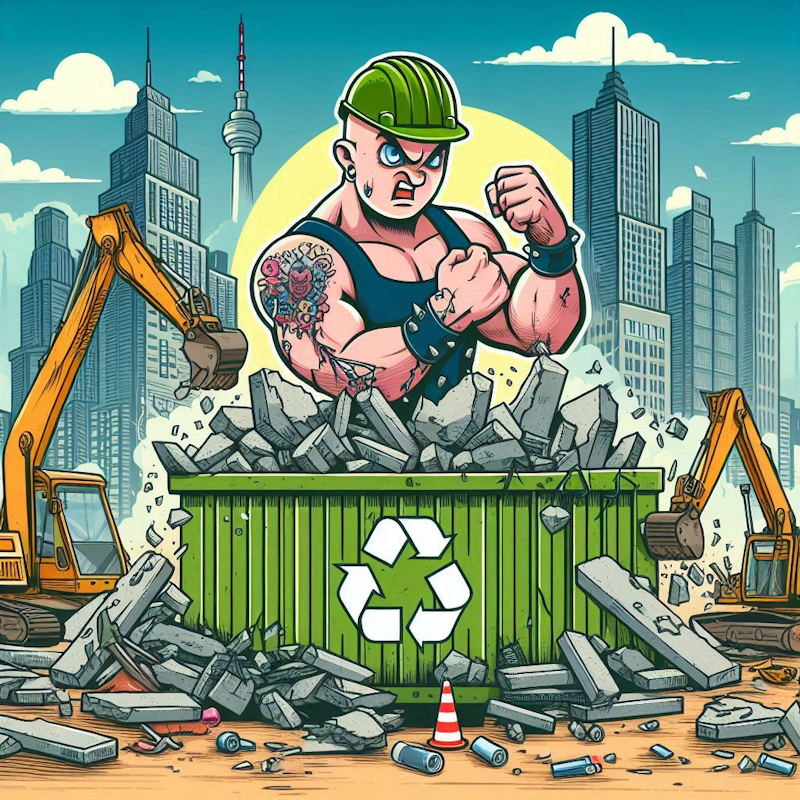Recycling construction concrete is a critical aspect of sustainable building construction and environmentally conscious practices in North Carolina cities like Concord. According to waste experts at Dumpster Rental Concord Team, a lot of improvements could be made in concrete recycling in NC, as it is often not considered by construction companies.
Because construction activities produce a considerable amount of waste, sustainable concrete recycling can help to reduce the volume of solid waste deposited in landfills while also lowering carbon footprints and promoting a circular economy. So let’s have a look at the methods of recycling construction concrete, how it is beneficial, and the approach for concrete recycling.
The need for recycling concrete
Concrete is one of the most distributed construction materials globally, and its production is mining-intensive. Given the precedent, the extraction of the elemental resources such as gravel and sand may destroy the environment. In addition to that the production process of cement, a prime element that makes up concrete, appears to be responsible for 8% of the global release of carbon dioxide.
Recycling concrete in NC can help to ameliorate this scenario and become more resource-efficient while simultaneously reducing carbon dioxide releases. The recycling of concrete involves distinct stages, starting with the acquisition of the concrete to reuse.
The following is how the recycling process looks:
Collection of concrete
The opening stage of the recycling process is to collect the waste material. The old concrete comes from broken slabs, sidewalks, building grounds, and other such structures. It is crucial to ensure that the collected material is devoid of metal, plastics, wood, or any other contaminants.
Transporting concrete
The collected concrete is transported to the recycling facility. It is crucial to handle the material carefully to prevent the formation of more waste and to avoid damage to the remaining material.
Crushing concrete
At the reusing facility, the concrete undergoes crushing. This is typically done using a machine called a jaw crusher or impact crusher. Moreover, the concrete size can differ based on the flags and its goal. For example, coarser cuts might be utilized as mainline while finer bins might be employed as part of the mixture.
Screening
Converted material is mechanically separated from the dirt, dust and other stuff. This process is to ensure that the recycled substance can be applied in different other forms and is of a standard quality.
Recycling
The processed material can be recycled to produce new things. Common applications include:
- Uses of Crushed Concrete Base Material: Crushed concrete is most commonly used as a base material for roads, driveways, and parking lots.-Cds describes this crushed concrete as providing a stable foundation while also saving users money on the need for new aggregates.
- Fresh New Concrete Production: Recycled concrete aggregates (RCA) can be used to produce a fresh New Mix of concrete, saves environment.
- Landscaping: Because crushed concrete is compact, you can use it in many other forms of landscaping as well.
- Fill material: Recycled concrete can also be used as fill for certain construction projects.
Advantages of recycling concrete
Recycled concrete has many benefits:
Environmental Impact: recycling concrete registers as a massive cost saving for the construction industry and more opportunities for contractors. This practice also helps to cut down on carbon emissions related to extracting and processing new materials.
Savings on Labour Costs: In some cases, using recycled concrete can also be cheaper than purchasing new materials—especially in the building of larger projects. It lowers transport as well as landfill expenses, making it a monetarily solid choice
Conservation of resources: Concrete recycling is a great way to help protect and conserve natural resources from being depleted. RCA is introduced to reduce the use of virgin aggregates, environmentally sustainable construction practices.
Future Regulatory Compliance: There are some places that either encourage or require construction material recycling, and you need to be able to track these goods. Construction companies can comply with these mandates by adopting recycling practices.
Concrete Recycling Best Practices
It is necessary to follow these best practices in order to optimize the benefits of concrete recycling:
Plan pre-demolition: Make sure to take the time, in advance of demolition, to critically assess all materials. Categorising concrete that can be recycled as opposed to waste can save tons in the recycling process and a fair few dollars back in your pocket.
Technology: Incorporate advanced technologies in concrete crushing and screening to produce superior recycled concrete output. The use of high-grade RCA will improve the output of new concrete mixes
The Quality Assurance: Monitor the quality of materials being recycled is part of assess if they meet industry requirements. A feature that is very important for structural concrete applications.
If records collection plan is successful, the next steps may hinge on your IoT data solution and eventually become a case of establishing good recycling networks (Collaboration: Engaging with local recycling facilities, dumpster rental services and contractors to create efficient recycle networks.). Working together can enhance logistics and raise recycling rates.
One of the most important ways to reuse construction concrete is through the highly beneficial method called recycling, which provides numerous benefits towards overall environmental sustainability and resource conservation. In this manner, the implementation of high quality recycling results and best practices in recycling at construction site help to decrease environmental impact and further enables to produce useful material for future project. Thus, converting to use of recycled concrete has a double benefit on the environment, as well as promoting economic efficiency in construction industry.



